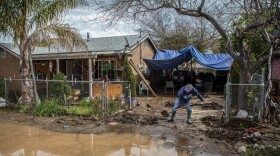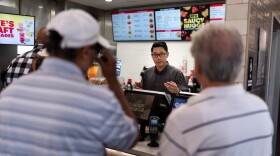Customs and Border Protection supplied munitions that the San Diego County Sheriff’s Department told KPBS it used to disperse crowds during protests in late May and early June.
According to a letter prepared by CBP, which was responding to questions from Sen. Kamala Harris (D-California), the San Diego County Sheriff’s Department requested assistance from CBP on five separate occasions during protests between May 31 and June 11. The letter was obtained by The Nation.
“On May 31st, as local and state resources became overtaxed and fatigued with the response to civil unrest in San Diego County, the Sheriff's Department requested assistance from U.S. Customs and Border Protection (CBP),” the sheriff’s department said in a statement.
The requests, which were among the most made by any law enforcement agency in the country during this time period, included assistance in the form of “less lethal munitions,” “crowd control” and “airborne” support.
The sheriff’s department told KPBS that in response to the requests, CBP delivered pepper balls and chemical agents — such as tear gas — after the department had depleted its supply of both. The agency said the tear gas did not meet its criteria, so it was not used.
Disputing the CBP document, the Sheriff’s Department said CBP agents were not used for crowd control, and that CBP agents did not make any arrests connected to the protests.
RELATED: Border Patrol’s Role In Policing Protests Remains Shrouded In Secrecy
CBP agents were present at the protests, however. The sheriff’s department said that CBP agents at the protests reported directly to the sheriff during the protests.
The letter also said the San Diego Police Department requested aid from CBP during the protests. SDPD told KPBS it made no such request.
The Port of San Diego’s Harbor Police also requested assistance, according to the letter. That agency told KPBS that the requested CBP agents were confined to the airport and did not directly assist harbor police.
The sheriff’s department said that all aspects of California’s SB 54, which limits cooperation between local law enforcement and federal immigration enforcement, were followed during the protests.
“It is important to note all aspects of SB54 were followed. This was not an immigration enforcement,” the department said. “CBP was only used to protect life and property. This was made clear to them at the time they responded to assist. Their assistance was very much appreciated and warranted.”
As CBP has responded to protests across the country in recent weeks, its role has come under intense scrutiny from politicians at the local and national level.
“This is certainly a grey area for what local law enforcement officials in San Diego and elsewhere in California, may or may not be able to do when it comes to reaching out to CBP, for example when there’s a protest,” said UC San Diego professor Tom Wong, who has studied interactions between local law enforcement and the Department of Homeland Security in San Diego. “It really does demand that more questions be asked about what the scope and the authority of what Customs and Border Protection is doing during a time of social unrest and increasing anxiety surrounding law enforcement.”
It’s very possible that California’s lawmakers could revisit laws governing interactions between the local police and federal agencies, especially in light of CBP’s long history of involvement in local law enforcement in San Diego, and now expanding to elsewhere in the country, he said.
“To the extent that CBP wants to see itself as a law enforcement agency that polices the interior of the United States, I think that is something outside the scope of its authority and outside the scope of its training,” Wong said.









